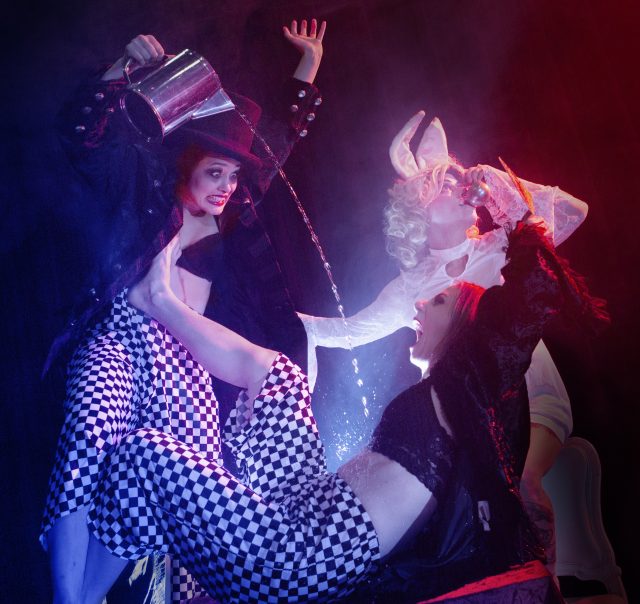
Lewis Carroll's novels Alice's Adventures in Wonderland and Through the Looking-Glass, and What Alice Found There are mainstays of popular culture, having been reinvented in just about every medium imaginable. With Wonder/Through the Looking-Glass Houses, Arrie Fae Bronson-Davidson and KineticArchitecture Dance Theatre add a new, all-female vision of Alice to that lineage. This reimagining is as much the White Rabbit's story as Alice's, and when we meet the Rabbit (Arrie Fae Bronson-Davidson)--who is, of course, running late -- during an opening dance scored by David Bowie's "Time," she is something of a vixen with glittering ruby lipstick and nary a waistcoat nor a pocket watch in sight. In a bit of departure from the original novels, this Rabbit pauses occasionally for selfies with the audience, but soon we are off down the rabbit hole with Alice and back on familiar Wonderland terrain.
The first half of the play covers touchstones well known to readers of Alice's Adventures: the caucus race, the Caterpillar, the Mad Hatter's tea party, the Queen of Hearts; and it even features excerpts from the novel itself read by Cheshire Puss (Dara Swisher). Allowing for its translation into dance theater, one could say that it is fairly faithful to the original, with the dance of the Butterfly (Chloe Markewich) the most clearly metaphorical section. Though credited as Butterfly, we only see her still trapped in the body of a caterpillar, learning or trying to learn to walk upright before ending the dance by entering her chrysalis. This changing self is not dissimilar to Alice in some ways, who is often caught up in the dances or others or attempting to imitate them, learning new ways of moving and being.
As Wonder moves into Looking-Glass Houses, it also begins to depart from Carroll's narrative more clearly and more often. The White Rabbit, channeling Marilyn Monroe, steps through onto the audience's side of the looking glass and talks about the professional and personal difficulties of being a trans rabbit performer. After this meta discussion (which includes some funny-because-it's-true asides about cis men's obsession with sexy bunnies and how rabbits should be cast in rabbit roles), the Rabbit moves back through the glass, and the dance that follows, with Alice (Cecily McCullough) yet to cross over, mixes physical strength and vulnerability and juxtaposes that mixture to a clip of the Disneyfied Alice. In the half of the play that follows, the allegorical elements suggested by the Butterfly become more pronounced, and Puss and the White Rabbit emerge as antagonists. Puss is akin to the god of Wonderland, the guardian of the book, protector of canonicity and enemy of reinterpretation, while the White Rabbit is rule-breaker and prefers to move outside the rules set by the Carrollian text. The prescribed goal in this half is to become the queen, and Puss welcomes Alice (who is "like them") to this game while doing her best to remove the Rabbit from contention. The closing dance takes place amidst questions of who can play the game, who belongs, and by what rules (should we even want the Rabbit to play?); and, like the staging that opens Book 2, it emphasizes bodies, bodies climbing over one another and pulling one another down in order to vie for the crown. The image is striking, reminiscent of the tangled piles of sinners in medieval paintings of hell, and equally striking is an evocation of Kali, sometimes considered Mother of the Universe.
In addition to the closing section, stand-out pieces of choreography include an early segment depicting Alice falling into Wonderland that makes excellent use of a pillow; the tea party with the Mad Hatter (Brittany Posas), the March Hare (Meghann Bronson-Davidson), and the Dormouse (a doll baby with mouse ears); and a very impressive, athletic display by the Tweedledee and Tweedledum (also Brittany Posas and Meghann Bronson-Davidson). Dara Swisher is fantastic as Puss, whether narrating or inhabiting her character in expressive detail, and McCullough looks like a stereotypical Alice but carves out her own unique interpretation of the heroine. This production preserves some of the darker undertones of the Alice narrative, imbuing especially the caucus race and tea party scenes with an understated menace. The soundtrack (some of which, mixed in wide stereo, produces interesting atmospheric effects in a theater setting) ranges from more thematically evocative choices, like CocoRosie's "Poison," to a live rendition of Jefferson Airplane's iconic "White Rabbit" by a swaggering Queen of Hearts (Miss Cherry Delight). There is also a very effective use of silence as part of the soundtrack at the end of the caucus race section, scored only by the steps and breathing of Alice and her fellow racers.
Alice, as someone who undergoes many changes, physical and otherwise, during her famous journeys to Wonderland, offers an apt vehicle for exploring the self. Even Lewis Carroll can be seen as a reinvention of Charles Dodgson. Wonder/Through the Looking-Glass Houses weaves this kind of exploration into a fun, adventurous show that brings its Victorian tale firmly into the 21st century, burbling as it comes. - Leah Richards & John Ziegler
